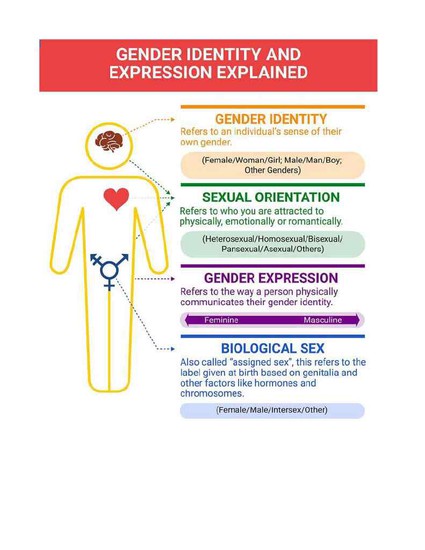Clarifying Terms Relating to Sex and Sexuality
Sex determination is the process that determines the biological sex of an offspring and, as a result, the sexual characteristics that will develop. Sex determination is the beginning of the development of many characteristics that influence how a human looks and functions as well as the societal expectations that other humans have for each other. The human Y chromosome plays a key role in determining the sex of a developing embryo. This is mostly due to a gene called SRY (“sex-determining region of Y”). SRY is found on the Y chromosome and encodes a protein that turns on other genes required for male development.
National Institute of Health guide on sex, gender, and sexuality provides clarifying definitions. Gender: “refers to socially constructed roles, behaviors, activities, and/or attributes that a given society associates with being a woman, man, girl, or boy, as well as relationships with each other. As a social construct, gender varies from society to society and can change over time.”
Cisgender person: “someone whose gender identity aligns with the sex assigned to them at birth; sometimes abbreviated as cis.”
Bisexual people “have the potential to be emotionally, romantically, or sexually attracted to people of the same and different gender— not necessarily at the same time, in the same way, or to the same degree.”
Gender expression “is how one chooses to convey one’s gender identity through behavior, clothing, and other external characteristics.”
Gender identity is an “individual’s sense of being a man, woman, boy, girl, genderqueer, nonbinary, etc. This identity is not necessarily visible to others.”
Gender non-conforming is a “person whose gender expression is not consistent with the societal or cultural norms expected of that gender.”
Intersex: a “general term used to refer to individuals born with, or who develop naturally in puberty, biological sex characteristics that are not typically male or female.” Hermaphrodite was the term previously used. Intersex is an umbrella term encompassing a variety of phenotypes, such as people with Swyer syndrome (one X and one Y in each cell but develop female reproductive structures), Klinefelter syndrome (XXY), Trisomy (XXX), or Turner syndrome (XO). Other combinations can occurXXYY, XXXY. or XYYY.
Differences in sex development (DSD) is an inclusive umbrella term.
Androgen Insensitivity Syndrome is a condition that keeps the brains of people with a Y from absorbing the information in that chromosome. Most of these people develop as female and may not even know about their condition until puberty — or even later.”
LGBTQIA+ “stands for lesbian, gay, bisexual, transgender, queer, intersex, and asexual. The plus sign includes other members of the community, such as genderfluid, nonbinary, or two-spirit, among others.”
Females tend to only have X chromosomes and the egg cells that they produce typically carry an X chromosome. Male sperm cell can carry either an X or Y. The sex chromosome a male sperm carries determines whether the offspring will develop into a male or a female (biological sex). Sex chromosomes (the X and Y) are structures in human cells made up of tightly bound deoxyribonucleic acid, or DNA, and proteins. These molecules contain instructions for the development of physical traits and body parts that correspond with each biological sex. Generally, those who inherit two X chromosomes (XX) typically develop as females, while humans with one X and one Y chromosome (XY) typically develop as males. Biological sex is generally determined at birth according to the baby’s chromosomes, gonads, and anatomy. The X-linked genes have distinctive inheritance patterns and are present in different numbers in females (XX) and males (XY). A combination of YY never occurs. There must be an X. Not every person with a Y chromosome is male. Not every person with a double X is female.
For further reading and clarification: check UCLA Williams School of Law for percentages
Sources
- https://www.nih.gov/nih-style-guide/sex-gender-sexuality
- https://embryo.asu.edu/pages/sexdetermination-humans
- https://www.webmd.com/a-to-z-guides/difference-between-sex-andgender
- https://www.rootsofloneliness.com/gender-identity
